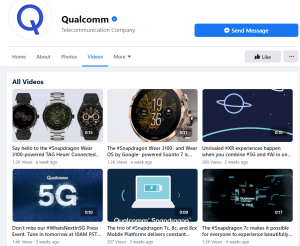
How can you create a website for small business marketing that will inspire more sales?
Many businesses like yours are not getting the sales you either need or want from their websites in spite of the fact that you are creating more content through landing pages, blogs, videos, or podcasts in 2016 than ever before.
Find out in today’s podcast or in the transcript below why so many businesses like yours are not getting the sales you should for the level of effort you putting into you small business marketing efforts and what you can do to inspire more sales through your website.
Transcript: Small Business Marketing and Inspiring Website Sales
How can you create a website for small business marketing that will inspire more sales?
Isn’t that why we as business owners need a website?
If you’re a service based business you want someone to pick-up the phone and call you.
If you’re a retailer you want someone to buy via ecommerce or you want them to come into your place of business or to your store.
If you’re an attorney or a consultant or if you’re in construction; there are all kinds of reasons and ways that you can use a website to help you build your business.
The bottom line for the majority of small businesses who have a website is that they want to increase their sales.
Today, you’re going to learn how to create a website that will inspire more sales.
The Reason Small Business Marketing Fails Online is Because of a Lack of Message
Many businesses are looking for strategies and tactics to build sales through their websites. But, there are is one primary thing that one should do before that to ensure that the right strategies and tactics are in place.
The first and primary means, the most import thing that goes into any small business marketing website to increase your sales is your message.
I an article I recently wrote titled “How to Create a Powerful Voice for Your Business” and shared that our goal as business owners, entrepreneurs and marketers is to figure out how to find our voice so that we can turn around and attract 20% of the audience who is able willing and ready to buy from us.
There are some studies they came out late last year that was transformative to small business marketing. One came from, believe it or not, IBM.
IBM has really been on some of the leading edge stuff for small business marketing as they’ve used their new artificial intelligent tool, called Watson, to help us understand consumer behavior.
One of the things that came out of their study was that people want to feel like businesses understand them.
Nearly 90% of marketers and business owner said in the survey, and there was about 6,000 of them, that they felt like they were doing a really, really good job of talking to the consumer and their prospects. The businesses surveyed were from different industries and represented retail, construction, manufacturing, service providers and consultants.
What they determine is that 90% of them, as business owners and marketers, felt they were doing a fantastic job.
But, there was a huge disconnect.
They also surveyed over 7,000 consumers.
These consumers said that when they got onto a website, that businesses were in no way relevant to their needs, problems, wants or desires.
I don’t know about you, but that screams to me there’s a huge disconnect and a major problem.
Here’s what I think is happening. I think we, as business owners, are so stuck in our own mindset. We are so connected into our own world, and we know what we want, that we think we are talking the language of the consumer when it couldn’t be any farther from the truth.
We are so out of the norm. We are so outside of how our consumers think that we actually get ourselves into a mode of believing our own stories in our head.
Then we wonder why our websites don’t translate.
We wonder why we are not getting more phone calls.
We wonder why our forms are not getting filled out.
We wonder why more people are not buying from us.
It’s just this huge disconnect between the world of the consumer and the world we live in as a business owner.
In another small business marketing study last year, the 2015 B2B Web Usability Report said that nearly 50% of all first-time visitors to a website left immediately because of a lack of message.
Many businesses have a singular focus on what their website will look like. Then they come up with their own ideas of what they want to communicate and what to put in the website.
What unintentionally happens is the business ends up talking way too much about themselves.
I guarantee you that you’re doing that. Your website probably talks way too much about you. It says what you sell, why people should buy what you sell, and how much it costs… and fill out the form (May 30, 2016).
Creating a profitable website takes work and learning how to ask the right questions in order to solve the right problems so that we can talk to the problems, needs, wants and desires of our site visitors.
Unfortunately, we’re too busy asking people to marry us, instead of asking people out for a cup of coffee.
Nobody wants to get in bed with you if they don’t know you; and what I don’t think you’re attractive?
What if they think that you might just be repulsive?
They are not going to want to get into bed with you.
 They’re not going to do anything because they think that you are a narcissist. That person thinks all you think about is yourself.
They’re not going to do anything because they think that you are a narcissist. That person thinks all you think about is yourself.
Subconsciously, this is exactly what’s happening on your website. People are getting onto your website and they’re looking at, and they’re saying to themselves consciously and subconsciously that your content doesn’t apply to them. They feel that your content is not relevant to them, and they end up not spending any time digging around your website and quickly go back to wherever they came from. That might be social media, that might be Google… that might be wherever.
They are going to go back to where they came from and start over and go to the next website. If the next website doesn’t connect they will go to the next website.
Then what they end up finding out is that many websites are all saying the same thing. They are just duplicating each other. I know why that is because, as a web designer and web developer, I have had hundreds of clients over the last 10 years and a lot of businesses are out there looking around at other websites and they’re saying to themselves;
“Ohh, I like this website, I like that website. I like what this one says and let’s take what that one says.”
Then, they start cherry picking all this content. They say;
Take that (content) and put it in my website and take this because I think that says what I want to say.”
The problem with that is; what if this other business doesn’t know the consumer either and they’re just making stuff up, or they stole it from somebody else?
Now, I don’t mean steal in terms of violating copyright or anything like that. But, I do mean steel in terms of you just took somebody else’s content that you don’t know if it was thought out or not and it sounded good to you, and you put it your website.
You have no way of knowing if that’s even relevant to your audience’s needs; and here’s where the small business marketing is changing… It is hyper focused. It’s hyper clear.
And yet most of us are not clear around our businesses.
Most of us are not clear about the consumer.
Most of us are not clear about the tangible values that we provide to our customers and how they feel about the experiences that they have with us.
We might know something about the end result but we don’t always know how they feel
Out of that tangible value and that experience, and how they felt about the experience, what specific problems did you solve?
I have a client right now who’s working through this process and what she’s discovering is that she’s got so many broad problems for each tangible value that she has to get more specific and narrow them down because they’re all grouping and there really duplicates of one another.
When you know the problems that you solve, what about who you’re solving them for?
Who is the specific person?
What is the profile of that person?
This is about relevancy. We want to be so relevant to the consumer that the consumer says to himself or herself;
“Oh my God, how did you know?
How did you know that’s what I was going through?
How did you know that’s what I was experiencing?
How did you know that’s where I want to be in three years?
How did you know that’s what I just came through?”
You want them to relate to you so personally that they get emotional because people make decisions based on emotion, not on logic.
But, when we go into our websites what we find is our websites are laced with raw logic and information, and people don’t buy on logic.
When we communicate with just logic and information what we are actually doing is a form of features and benefits.
Features and benefits are nothing more than mass marketing and we already know that mass marketing doesn’t work anymore, at least not at the way that it used to work. Why? Because the internet is hyper-specific and mass marketing is really broad.
I would rather have 10 people on a highly specific, targeted page designed to attract one person who is able willing and ready to buy from me over 10,000 people that are just browsing and are just looking for ideas to help them and never have any intention of buying.
Yet, that’s what’s happening out there. Many websites are attracting people that are looking for general information and are not really ready to do anything or don’t have an interest in doing anything, and they stumble across your site as they go. They might think the content is a little interesting, and then a pop-up.
They think to themselves;
“You want me to download what?”
They have no reason to do fill out your form because that’s not why they are on your website.
But, when we get really specific our websites start selling more.
The traffic might come down, but if your website visitors are more focused and they’re able, willing and ready to buy, and that’s why they’re there; then the profitability of your website just went up.
That’s what you’re really after!
Over time if you start writing blog articles that solve one problem, for one person, and give them one solution; what you begin to see is the traffic on your site over a six month, one year, a two year and three year period really starts to elevate and come up.
The reason is because those older articles that are still highly relevant and highly specific are still attracting people.
Over time, your website is gradually expanding its audience reach as you’re doing an article, or a podcast or a video a day, or once a week, or once every two weeks… whatever the case may be.
Frequency isn’t as important as specificity.
If you get your specific message down right, over time your small business marketing will start to attract the audience in larger numbers that will begin to boost your sales online significantly.
That’s the goal.
That’s what you’re after.
Business & Finance Articles on Business 2 Community
(16)






